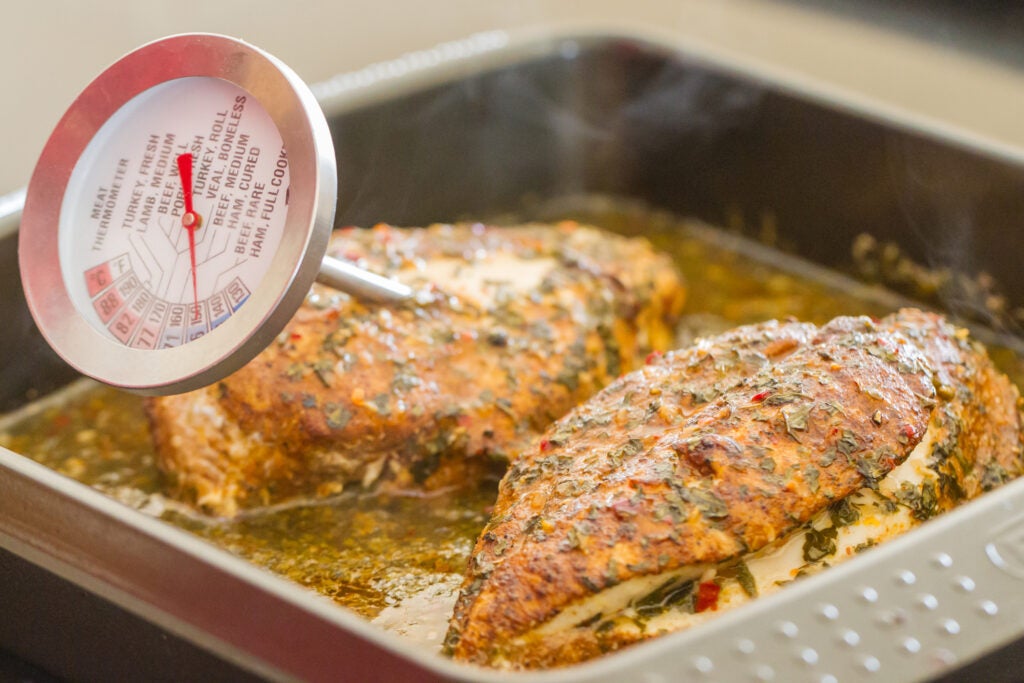The temperature danger zone has its name for a reason. A single bacterium doubles every 20 minutes in the right conditions, meaning it can multiply trillions of times in just 24 hours without proper attention to food safety. The temperature danger zone is between 41℉ and 135℉—a temperature range in which pathogens grow well. Harmful microorganisms can grow to levels high enough to cause illness within four hours.
Foods That Need Time and Temperature Control
Any type of food can host contaminants, but some foods are better than others for the growth of pathogens. Foods that need time and temperature control for safety—known as TCS foods—include milk and dairy products, eggs, meat (beef, pork, and lamb), poultry, fish, shellfish and crustaceans, baked potatoes, tofu or other soy protein, sprouts and sprout seeds, sliced melons, cut tomatoes, cut leafy greens, untreated garlic-and-oil mixtures, and cooked rice, beans, and vegetables.
How to Thaw TCS Foods
TCS food can be thawed one of four ways:
- Refrigeration — thaw at a temperature of 41℉ or lower.
- Running Water — submerge food under running water at 70℉ or lower.
- Microwaving — only to be used if food will be cooked immediately after thawing.
- Cooking — include thawing in the cooking process.
Time & Temperature Control Food Holding Temperatures
- Cold foods must be maintained at 41℉ or less.
- Hot food must be maintained at 135℉ or above.
- Be sure to check the temperature at least every four hours.
- Checking the temperature every two hours would be ideal to leave time for corrective action.
- Throw out food that is not 41ºF or lower, or 135ºF or higher.
Cooling Foods
Food must pass through the temperature danger zone quickly to reduce the growth of pathogens. First the food must be cooled from 135℉ to 70℉ within two hours, then cooled to 41℉ or lower in the next four hours. If the food has not reached 70℉ within two hours, it must be thrown out or reheated and then cooled again. The total cooling time cannot be longer than six hours.
The most effective way to cool food is to reduce its size. This involves dividing large containers of food into smaller containers or shallow pans.
Methods for cooling foods include:
- Ice-water bath
- Ice paddle
- Blast or tumble chiller
- Using cold water as an ingredient (soups, stews, etc.)
***Note: Coolers are designed to keep cold food cold, not to cool hot food quickly.
Reheating Time and Temperature Control Foods
Food that will be served immediately can be reheated to any temperature as long as the food is cooked and cooled properly. Food reheated for hot-holding must reach an internal temperature of 165℉ within two hours. The food needs to stay at this temperature for at least 15 seconds before serving.
Prioritize Food Safety for Your Business
Prioritizing food safety, particularly when handling TCS foods, is essential for your business. By being aware of the temperature danger zone and practicing proper food handling techniques, you can significantly minimize the risk of contamination. Following these helpful guidelines will reduce the risk of foodborne illnesses and keep your customers safe.
Remember, time and temperature are key to food safety. By adhering to the recommended temperature ranges and minimizing time spent in the “danger zone,” you can significantly reduce the risk of foodborne illnesses and protect the health of your customers, patients, or residents. Learn more about creating a culture of food safety in your foodservice operations here.




























